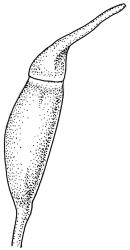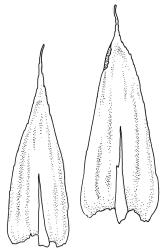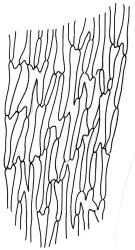- = Leucodon implexus Hook.f., Handb. New Zealand Fl. 457 (1867) nom. illeg.
Plants soft, yellow-green, glossy, forming extensive cushions to 0.5 m or more in diameter, usually epiphytic. Stems pale green, in cross section with 2–3 layers of thick-walled cortical cells and an ill-defined central strand, densely beset and bound together by rust-coloured, smooth rhizoids. Branches erect, not or sparsely branched, to c. 15 mm long; microphyllous branches with small (c. 0.5–1.0 mm), non-plicate, ecostate leaves frequently present and abundant. Leaves not or weakly 6-ranked (when moist), closely spaced, erect-spreading, symmetric, strongly plicate to base of acumen, slightly rugose only at apices, broadly lanceolate and rather abruptly tapered to a slender acumen that is c. 0.1 the total leaf length, plane at margins, moderately concave, not decurrent, serrulate in upper half or more, 2.0–2.5 × 0.6–0.7 mm; acumen 0.2–0.6 mm; mid laminal cells faintly porose, 39–60 × 4–5 μm, somewhat longer (to c. 75 μm) in lower portion of leaf, but not otherwise differentiated; alar and extreme basal cells shorter and wider, but not forming a well-defined group. Costa single, often bifurcate, c. ⅓ the leaf length.
Apparently dioicous. Perichaetia on lower portions of vegetative branches, c. 1 mm long, but elongated to c. 2–3 mm following fertilisation, with leaves broadly lanceolate, tubular, ecostate, spreading at apices. Perigonia not seen. Setae 9–14 mm, straight, c. 150 μm diam. not or twisted very weakly to the left, red-brown; capsules oblong or short cylindric from a short, rugose neck, 2–3 mm, pale red-brown; exothecial cells weakly thickened in corners; operculum 1.2–1.7 mm. Peristome single; exostome teeth absent; endostome with basal membrane extending c. 100 μm past the capsule mouth, segments c. 315–415 μm long, keeled, irregular in outline and often anastomosing in upper half, finely papillose-lirate throughout and cilia absent or rarely present and rudimentary. Calyptra 4.0–5.0 mm. Spores 13–18(–24) μm, pale brown.
Sainsbury 1955, pl. 55, 1; Allen 1999, figs 2–3; Malcolm & Malcolm 2003, p. 41.
The microphyllous secondary branches present are especially abundant on the central, older portions of L. australis colonies. With reduced (c. 0.5–1.0 mm), non-plicate, and narrowly ovate-lanceolate leaves, these shoots are often extremely numerous and, if collected in isolation of more typical portions of the plant, could well be misnamed, likely as a species of Hypnum. The contorted apical portions of the leaves, and the faintly porose nature of the laminal cells, however, are suggestive of their true identity. The microphyllus branches may produce deciduous buds (as in B.H. Macmillan 73/522 from Lowry Peaks Range, Canterbury L.D., CHR 242150!), and both structures probably serve a dispersal function.
NI: S Auckland, Gisborne (Rākauroa Scenic Reserve, numerous sites near Lake Waikaremoana), Hawke’s Bay (Tūrangakumu, Puketīriri, Makahu River), Wellington; SI: Nelson, Marlborough, Canterbury, Westland (Ōtira Gorge, Kelly Range), Otago, Southland. The lack of collections from St is curious and may be in part due to the absence of southern beech trees on that island.
Australasian. Reported from Tasmania by Klazenga (2012) on the basis of two modern collections from the Lake St Clair region. Allen (1999) also cited a historical Mueller collection from "Nov. Holl.", suggesting that this species might occur in Vic.
Growing on tree trunks and large branches, less commonly on rocks or soil, primarily in drier parts of the country. On the North I. documented from 110 m (Ahi Paku Station in eastern Wairarapa, Wellington L.D.) to 1300 m (Ōhakune Mountain Road, Wellington L.D.) and on the South I. from c. 30 m (Pelorus Bridge Scenic Reserve, Marlborough L.D.) to at least 1600 m (Mt Tapuaenuku, Marlborough L.D.), but probably extending to over 1700 m. On the South I. this species is best developed in southern beech forest east of the Main Divide and is nearly absent from regions of high rainfall. It is often abundant in drier sites and can produce pure colonies extending 4 m or more in greater diameter on Fuscospora spp. trunks and large branches. It also occurs on the genera Beilschmiedia, Carpodetus, Griselinia, Hoheria, Olearia, Pennantia, Plagianthus, and Pseudopanax, as well as the gymnosperms Dacrycarpus dacrydioides, Dacrydium cupressinum, Prumnopitys ferrugineus, and Phyllocladus.
Leucodon implexus Hook.f. [Handb. N. Zeal. Fl. 457, 1867] is illegitimate since at the time of its publication Hooker cited the legitimate Leucodon hexastichus Mont. in synonymy. As noted by Allen (1999), Brotherus (1901–1909) subsequently made direct reference to the illegitimate Leucodon implexus in the protologue of Lepyrodon australis Hampe ex Broth., apparently the first legitimate name for this taxon based on a N.Z. type.
Leucodon implexus Hook.f. nom. illeg. is founded on two syntypes from Nelson and Otago, collected by Sinclair and Hector & Buchanan, respectively. Allen (1999) designated the Sinclair collection, represented in NY, as the lectotype of both Lepyrodon australis and Leucodon implexus.
The continued use here of the name Lepyrodon australis rather than the South American L. hexastichus is a convenience and follows Allen (1999). The type of L. hexastichus (Mont.) Wijk & Marg. (Chili austral., Gay, BM-Besch.!) lacks intact capsules. The plants have many leaves with fragmented apices, but on some branches the slender and serrate acumens are intact. The upper portions of the shoots are decidedly six-rowed when wet. South American specimens in BM accord well with the range of variability of N.Z. material, but comparison to a wider range of material is warranted. In the only fruiting material available for study (S. Yakubsen 10772, Argentina, Isla el Centinela, Lago Nahuel Haupi, CHR 645984), peristome segments appear smoother than in N.Z. material. Material with six-ranked leaves occurs at Peel Forest (Canterbury L.D., T.W.N. Beckett, Jan. 1900, CHR 645983!, BM!). If the two names prove to be synonymous, the South American name has priority.












